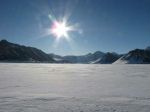
Amount of solar radiation incident, per unit area and time, on a surface which is perpendicular to the radiation and is situated at the outer limit of the atmosphere, the earth being at its mean distance from the sun. It equals approximately 2.00 ly/ min ...

